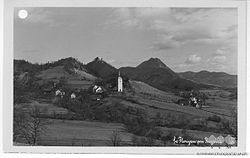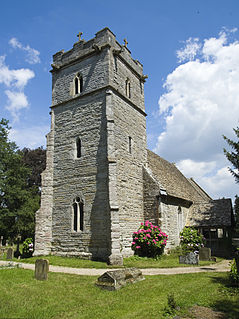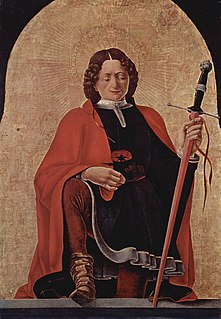
Prebold is a settlement in central Slovenia. It is the seat of the Municipality of Prebold. It lies on the edge of the lower Savinja Valley at the northern edge of the Sava Hills west of Celje. The area was part of the traditional region of Styria. The municipality is now included in the Savinja Statistical Region.

Miklavž na Dravskem Polju is the largest settlement and the seat of the Municipality of Miklavž na Dravskem Polju in northeastern Slovenia. It lies on the right bank of the Drava River southeast of Maribor. The area was part of the traditional region of Styria. It is now included in the Drava Statistical Region.

Benedikt is the central settlement in the Municipality of Benedikt in northeastern Slovenia. Before 1998, it was part of the Municipality of Lenart. It lies in the Slovene Hills. The area was part of the traditional region of Styria. It is now included in the Drava Statistical Region.

Sveti Florijan nad Škofjo Loko is a small settlement in the Municipality of Škofja Loka in the Upper Carniola region of Slovenia. The church of Saint Florian on a hill above the village, though actually belonging to the neighbouring village of Sopotnica, gave its name to the settlement.

Jurski Vrh is a settlement in the Municipality of Kungota in the western part of the Slovene Hills in northeastern Slovenia, right on the border with Austria. It includes the hamlet of Jurij ob Pesnici, on the left bank of the Pesnica River, as well as the dispersed houses in the hills north of the village.
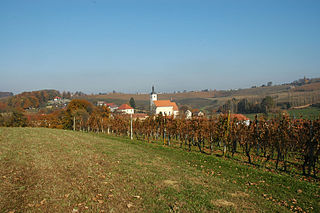
Miklavž pri Ormožu is a settlement in the hills northeast of Ormož in northeastern Slovenia. The area traditionally belongs to the Styria region and is now included in the Drava Statistical Region.

Kamence is a settlement in the Municipality of Rogaška Slatina in eastern Slovenia, close to the border with Croatia. The area traditionally belonged to the region of Styria. It is now included in the Savinja Statistical Region.

Male Rodne is a settlement in the Municipality of Rogaška Slatina in eastern Slovenia. The entire area traditionally belonged to the Styria region and is now included in the Savinja Statistical Region.

Strmec pri Svetem Florijanu is a settlement in the Municipality of Rogaška Slatina in eastern Slovenia. The entire area was traditionally part of the region of Styria. It is now included in the Savinja Statistical Region.

Podkum is a settlement in the Municipality of Zagorje ob Savi in central Slovenia. The area is part of the traditional region of Lower Carniola. It is now included with the rest of the municipality in the Central Sava Statistical Region.

Ravenska Vas is a settlement immediately east and southeast of Zagorje ob Savi in central Slovenia. The area is part of the traditional region of Upper Carniola. It is now included with the rest of the municipality in the Central Sava Statistical Region.

Gore is a settlement in the Municipality of Hrastnik in central Slovenia. Traditionally the area was part of the Styria region. It is now included with the rest of the municipality in the Central Sava Statistical Region.

Urh is a small settlement in the Pohorje Hills in the Municipality of Slovenska Bistrica in northeastern Slovenia. The area is part of the traditional region of Styria. It is now included with the rest of the municipality in the Drava Statistical Region.

Jelovice is a settlement in the western Haloze Hills in the Municipality of Majšperk in northeastern Slovenia. The area is part of the traditional region of Styria. It is now included with the rest of the municipality in the Drava Statistical Region.

Miklavž pri Taboru is a dispersed settlement in the Municipality of Tabor in central Slovenia. The area is part of the traditional region of Styria. The municipality is now included in the Savinja Statistical Region.

Sveti Jernej is a village in the Municipality of Slovenske Konjice in eastern Slovenia. The area is part of the traditional region of Styria. The municipality is now included in the Savinja Statistical Region.

Sveti Štefan is a small settlement in the Municipality of Šmarje pri Jelšah in eastern Slovenia. It lies in the hills south of Šmarje in the Kozje region. The area is part of the traditional region of Styria. The municipality is now included in the Savinja Statistical Region.

Močle is a village in the Municipality of Šmarje pri Jelšah in eastern Slovenia. It lies in the hills west of Šmarje. The area is part of the historical Styria region. The municipality is now included in the Savinja Statistical Region. It is a clustered village on the south side of a gentle slope. It includes the hamlets of Erpoge and Sveti Lovrenc.

Šentvid pri Planini is a village east of Planina pri Sevnici in the Municipality of Šentjur in eastern Slovenia. The area is part of the historical Styria region. The municipality is now included in the Savinja Statistical Region.
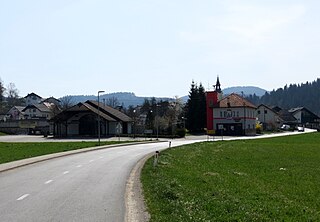
Šent Jurij is a village in the Municipality of Grosuplje in central Slovenia. The area is part of the historical region of Lower Carniola. The municipality is now included in the Central Slovenia Statistical Region.
